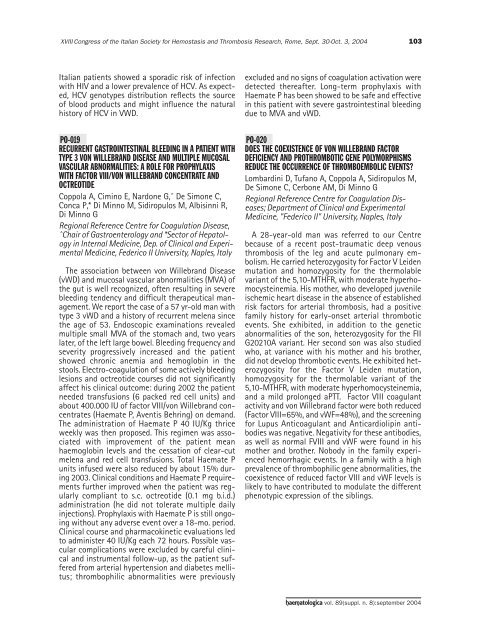Haematologica 2004;89: supplement no. 8 - Supplements ...
Haematologica 2004;89: supplement no. 8 - Supplements ...
Haematologica 2004;89: supplement no. 8 - Supplements ...
- No tags were found...
Create successful ePaper yourself
Turn your PDF publications into a flip-book with our unique Google optimized e-Paper software.
XVIII Congress of the Italian Society for Hemostasis and Thrombosis Research, Rome, Sept. 30-Oct. 3, <strong>2004</strong>103Italian patients showed a sporadic risk of infectionwith HIV and a lower prevalence of HCV. As expected,HCV ge<strong>no</strong>types distribution reflects the sourceof blood products and might influence the naturalhistory of HCV in VWD.PO-019RECURRENT GASTROINTESTINAL BLEEDING IN A PATIENT WITHTYPE 3 VON WILLEBRAND DISEASE AND MULTIPLE MUCOSALVASCULAR ABNORMALITIES: A ROLE FOR PROPHYLAXISWITH FACTOR VIII/VON WILLEBRAND CONCENTRATE ANDOCTREOTIDECoppola A, Cimi<strong>no</strong> E, Nardone G,^ De Simone C,Conca P,* Di Min<strong>no</strong> M, Sidiropulos M, Albisinni R,Di Min<strong>no</strong> GRegional Reference Centre for Coagulation Disease,^Chair of Gastroenterology and *Sector of Hepatologyin Internal Medicine, Dep. of Clinical and ExperimentalMedicine, Federico II University, Naples, ItalyThe association between von Willebrand Disease(vWD) and mucosal vascular ab<strong>no</strong>rmalities (MVA) ofthe gut is well recognized, often resulting in severebleeding tendency and difficult therapeutical management.We report the case of a 57 yr-old man withtype 3 vWD and a history of recurrent melena sincethe age of 53. Endoscopic examinations revealedmultiple small MVA of the stomach and, two yearslater, of the left large bowel. Bleeding frequency andseverity progressively increased and the patientshowed chronic anemia and hemoglobin in thestools. Electro-coagulation of some actively bleedinglesions and octreotide courses did <strong>no</strong>t significantlyaffect his clinical outcome: during 2002 the patientneeded transfusions (6 packed red cell units) andabout 400.000 IU of factor VIII/von Willebrand concentrates(Haemate P, Aventis Behring) on demand.The administration of Haemate P 40 IU/Kg thriceweekly was then proposed. This regimen was associatedwith improvement of the patient meanhaemoglobin levels and the cessation of clear-cutmelena and red cell transfusions. Total Haemate Punits infused were also reduced by about 15% during2003. Clinical conditions and Haemate P requirementsfurther improved when the patient was regularlycompliant to s.c. octreotide (0.1 mg b.i.d.)administration (he did <strong>no</strong>t tolerate multiple dailyinjections). Prophylaxis with Haemate P is still ongoingwithout any adverse event over a 18-mo. period.Clinical course and pharmacokinetic evaluations ledto administer 40 IU/Kg each 72 hours. Possible vascularcomplications were excluded by careful clinicaland instrumental follow-up, as the patient sufferedfrom arterial hypertension and diabetes mellitus;thrombophilic ab<strong>no</strong>rmalities were previouslyexcluded and <strong>no</strong> signs of coagulation activation weredetected thereafter. Long-term prophylaxis withHaemate P has been showed to be safe and effectivein this patient with severe gastrointestinal bleedingdue to MVA and vWD.PO-020DOES THE COEXISTENCE OF VON WILLEBRAND FACTORDEFICIENCY AND PROTHROMBOTIC GENE POLYMORPHISMSREDUCE THE OCCURRENCE OF THROMBOEMBOLIC EVENTS?Lombardini D, Tufa<strong>no</strong> A, Coppola A, Sidiropulos M,De Simone C, Cerbone AM, Di Min<strong>no</strong> GRegional Reference Centre for Coagulation Diseases;Department of Clinical and ExperimentalMedicine, "Federico II" University, Naples, ItalyA 28-year-old man was referred to our Centrebecause of a recent post-traumatic deep ve<strong>no</strong>usthrombosis of the leg and acute pulmonary embolism.He carried heterozygosity for Factor V Leidenmutation and homozygosity for the thermolablevariant of the 5,10-MTHFR, with moderate hyperhomocysteinemia.His mother, who developed juvenileischemic heart disease in the absence of establishedrisk factors for arterial thrombosis, had a positivefamily history for early-onset arterial thromboticevents. She exhibited, in addition to the geneticab<strong>no</strong>rmalities of the son, heterozygosity for the FIIG20210A variant. Her second son was also studiedwho, at variance with his mother and his brother,did <strong>no</strong>t develop thrombotic events. He exhibited heterozygosityfor the Factor V Leiden mutation,homozygosity for the thermolable variant of the5,10-MTHFR, with moderate hyperhomocysteinemia,and a mild prolonged aPTT. Factor VIII coagulantactivity and von Willebrand factor were both reduced(Factor VIII=65%, and vWF=48%), and the screeningfor Lupus Anticoagulant and Anticardiolipin antibodieswas negative. Negativity for these antibodies,as well as <strong>no</strong>rmal FVIII and vWF were found in hismother and brother. Nobody in the family experiencedhemorrhagic events. In a family with a highprevalence of thrombophilic gene ab<strong>no</strong>rmalities, thecoexistence of reduced factor VIII and vWF levels islikely to have contributed to modulate the differentphe<strong>no</strong>typic expression of the siblings.haematologica vol. <strong>89</strong>(suppl. n. 8):september <strong>2004</strong>
















